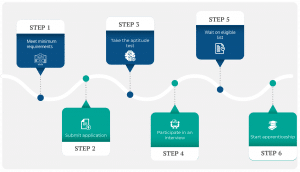The Birkman Assessment Test is a personality assessment tool that many companies use to evaluate job applicants. It was created by Dr. Roger Birkman in 1940. It measures a candidate’s behavioral styles, stress behaviors, motivations, and expectations.
The assessment is designed to give organizations a better understanding of a candidate’s
personality which can help them make more informed hiring decisions. It gives companies a clear picture of how a candidate may perform in a specific role and how they may interact with colleagues and clients.
Did you know?
The Birkman Assessment consists of 129 statements that repeat themselves in two manners and 58 ranking questions regarding career path preferences. It creates your personality profile based on two primary comparisons: 1.) Comparing your self-perceptions and your perceptions of most people in the world. 2.) Comparing your personality profile with your occupational preferences. It offers customized reports for different industries and professions for recruitment and self-growth purposes.
The Birkman Assessment questionnaire is mainly made up of true or false statements. While there’s no time limit to complete the test, it usually takes about 45 minutes.
Even though you can’t fail a Birkman assessment, it’s important to become familiar with the question types and test format. This will give you a better understanding of the questions, including any hidden purposes, and help you provide more accurate answers. It will increase your chances of being selected for the role.
Birkman Question Types Explained
The Birkman Questionnaire consists of 258 questions in true/false format which are based on the concept of one’s self and 58 multiple choice questions which the candidate has to rank based on their opinions.
Format of Birkman True and False Statements
The Birkman Questionnaire can be divided into two parts containing 258 and 58 statements, respectively:
The first part consists of two types of statements:
Set 1 – Perceptions of Oneself: 129 true and false questions starting with the “I” statement.
Set 2 – Social Perceptions: 129 true and false questions starting with the “ Most people” statement. This section aims to measure an individual’s:
- Usual behavior and interaction style, mostly those behaviors which are considered positive and effective in nature.
- Needs and expectations – the conditions that predict a sense of fulfillment or frustration.
- Interests and preferences, which are associated with work-related motivations.
- Stress behaviors, which are usually ineffective in dealing with relationships or tasks.
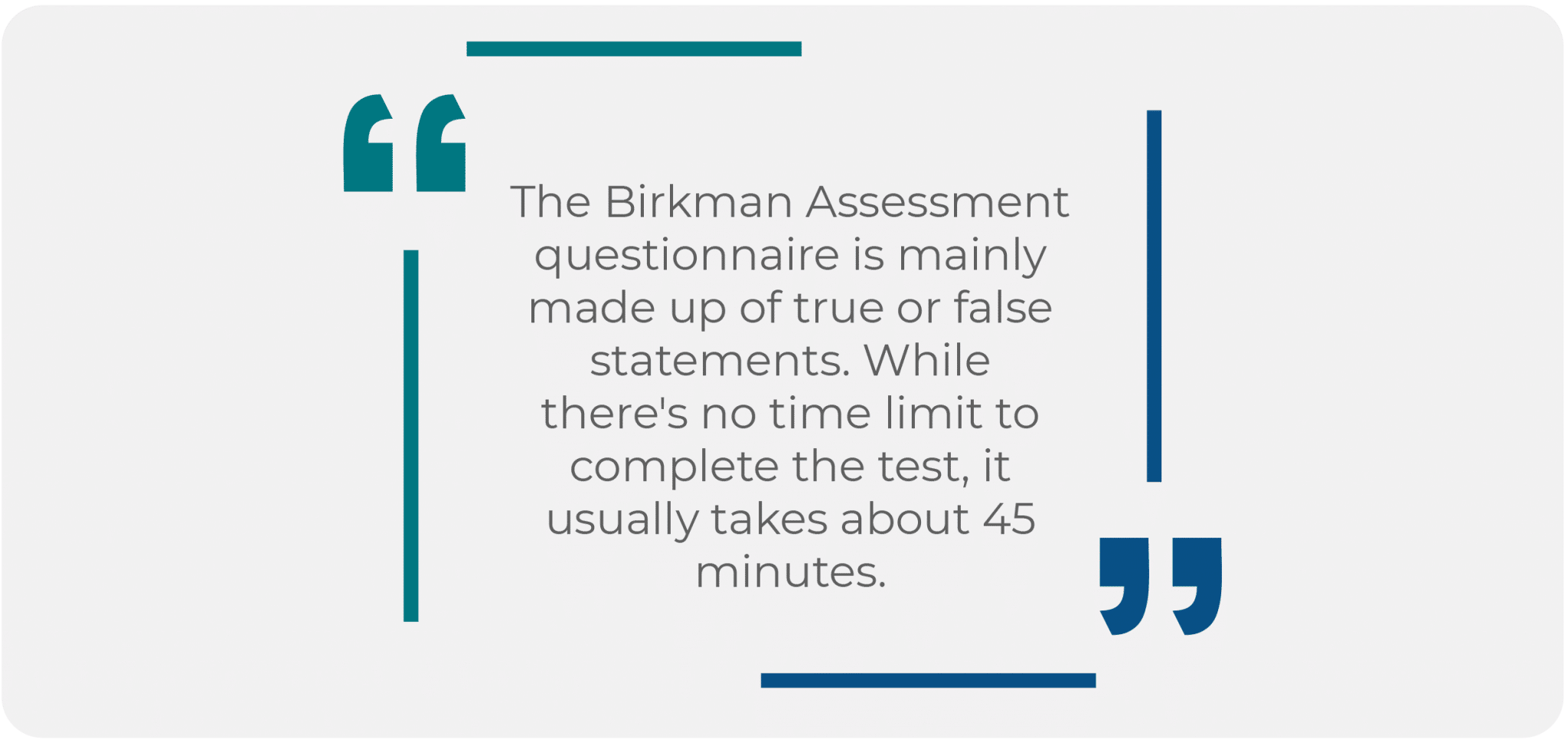
Sample True and False Questions
| Statement | True | False |
|---|---|---|
| I get worried about deadlines at work. | ||
| I don’t think much before speaking. | ||
| Most people feel comfortable with new people. | ||
| Most people believe that they are more competitive than others. |
Format of Birkman MCQ statements
The second part is a multiple-choice section with 58 questions. Each question consists of various professions, and the candidates have to arrange those choices according to their preferences.
They will rank the profession they prefer on top while the least preferred one gets the lowest ranking. While answering these questions, it is assumed that the listed jobs offer equal compensation and that one’s talent or skills won’t be a barrier.
Sample of Birkman MCQ Statements
| Which job do you prefer? Rank the job titles in order from most desired to least desired. |
|---|
| Sales Manager |
| Engineer |
| Math Teacher |
| Author |
Birkman Method Breakdown
Dr. Birkman’s US Air Force experience formed the basis of the Birkman assessment method. During his service time in the air force, he observed that individuals’ underlying motivations and perceptions significantly impact their training and performance.
These factors are categorized into Four Personality Perspectives:
- Motivation
- Self-Perception
- Social Perception
- Mindset
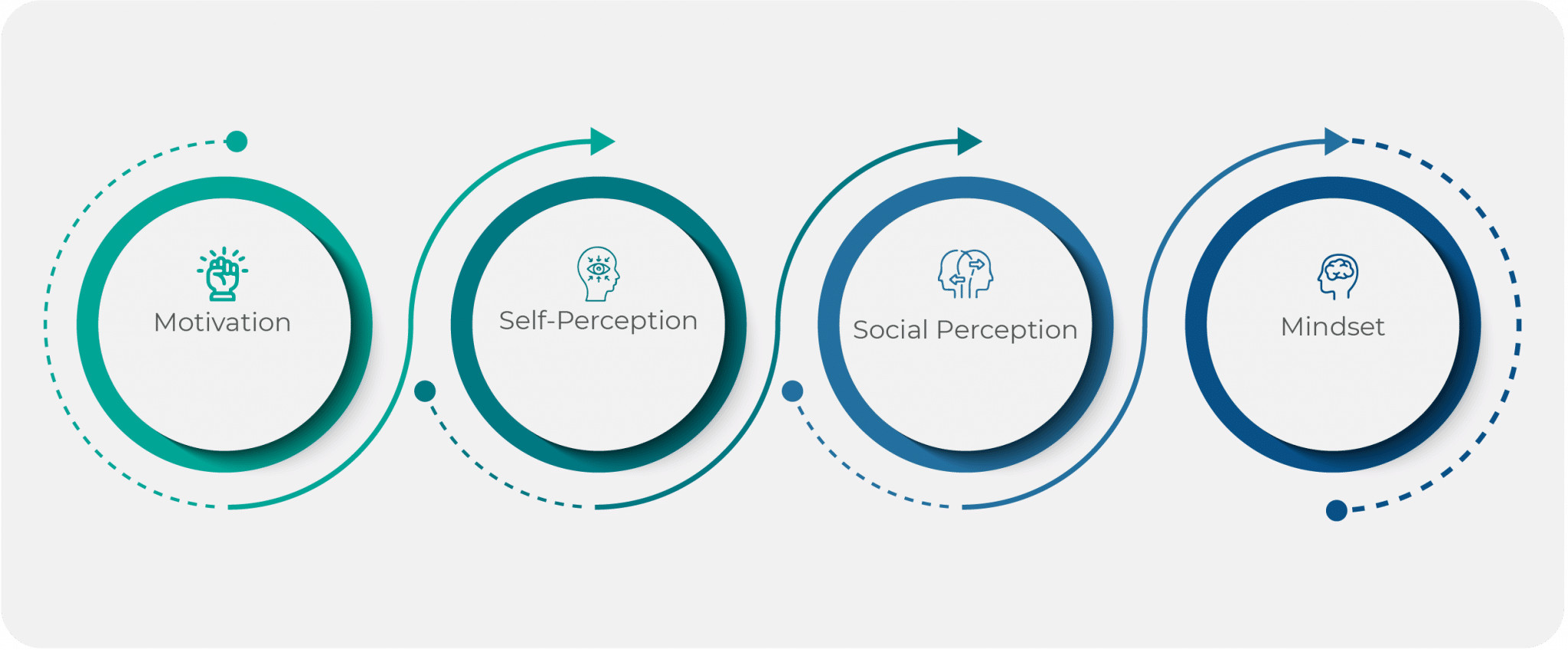
Personality Perspective Comparison Table
| Motivation | Self-Perception | Social Perception | Mindset | |
|---|---|---|---|---|
| What it helps you measure | Interest in various jobs, based on multiple traits such as persuasive, creative, or numerical. | How good you are at managing relationships with co-workers. | Your perception and understanding of social situations, and self-awareness. | What an individual believes to be true about people in his social circle and himself. |
| What it identifies | Which tasks interest you and which deplete your motivation. | Your productivity level. | The environments in which you are most productive. | The main driver behind your actions and behavior patterns. |
Birkman Preparation Strategies
There is no wrong answer to the questions on the Birkman Personality assessment. The test is designed to provide your employers with a better understanding of your behavioral traits. The assessment is utilized to determine whether a person is eligible for a particular role. It also judges your responses to specific scenarios.
The most crucial aspect of your Birkman test is honesty. Your prospective employer gets a realistic interpretation of your personality while you get the assurance that your chosen career path is the best fit for you. This ensures the best outcomes for everyone involved.
Although the test is not very complicated, you can prepare for it by following the steps mentioned below:
1. Try Online Practice Assessments
Every psychometric assessment brings a certain amount of stress; after all, your career depends on it. Test-day nerves are common, but they can be easily tackled if you know what to expect.
A considerable number of personality tests are readily available online. Although these tests are not exactly like the Birkman assessment, they will give you an idea of what to expect.
2. Gain Knowledge About Your Potential Employer
Just like understanding the job role you are applying for is crucial, getting an insight into the culture, vision, mission, etc. of the company you are applying for is also important.
Researching the work culture and core values of the organization will help you analyze whether your personality aligns with the role. You may consider manipulating your answers accordingly. However, it’s best to answer honestly and get a better understanding of your personality.
The more you are aware of your strengths and weaknesses, the better you’ll be prepared to answer questions sincerely.

3. Do Not Try To Manipulate The Test
Tricking a personality test is never recommended. The Birkman personality assessment has been in existence for over 60 years and has been consistently improved to provide more accurate profiling as time goes on.
You might think it is wise to fake your personality to become eligible for a particular job, but presenting a different personality will do more harm than good.
For instance, if you land a job as a manager by faking your personality, you will be under continuous stress to transform your personality into the one you presented on the test.
In the worst-case scenario, your employer might be able to figure out that you tricked the assessment. This might even cost you your job.
4. Find a Proper Preparation Course for the Birkman Assessment
Some say that there is no proper method to get prepared for Birkman Assessment. These are nothing but rumors. If you are familiar with the format of the assessment, you won’t be stressed out on D-Day. Understanding what the employer is actually looking for will help you respond accordingly.
It’s important to note that there’s a lot of misinformation going around concerning the Birkman Assessment. Statements like never show your weaknesses, never exhibit any negative feelings, or don’t answer honestly, are all traditional and have been passed on from generation to generation. The test has changed significantly over the years as has the answering strategy. A professional Birkman Assessment Course will allow you to get the best possible results.
Birkman Test Features
Birkman Personality Assessments Fast Facts
- True and False Questions: 258
- MCQs: 58
- No time limit but it generally takes 45 minutes to complete.
- Administered online
- Available in more than 21 different languages
- The results are delivered in a report format represented through a map of color grids where different symbols and color grids are utilized to represent the individual’s personality.

Reveals Four Key Perspectives Of Personality
The Birkman Personality Assessment reveals four significant perspectives of every individual personality: Motivation, Social-Perception, Self-Perception, and Mindset. Familiarity with these perceptions can give individuals a better understanding of their emotions and how they drive their decisions in real-life.
Motivation: Birkman’s motivation data helps measure an individual’s interests and passion for different roles. It measures broad interest themes that are characteristic of various occupations. This is a critical factor in determining an individual’s career path, engagement at the workplace, and workplace satisfaction.
Self-perception: Self-perception measures how people approach tasks, contribute to their community, and manage relationships. It reveals how an individual visualizes themself and presents themself in front of the world. It is mainly driven by how people use specific techniques to drive positive outcomes.
Social Perception: This is a filter used by an individual to determine if they feel comfortable in their current environment. As this is a measure of internal state, other individuals won’t be able to figure out how someone will react to environmental changes. This information allows a person to determine his reaction to changed situations in his life. It is a crucial driving force behind an individual’s behavior.
Mindset: Birkman’s data on mindset provides an understanding of an individual’s belief system regarding themself and other people. Different aspects of attitude are addressed by Birkman, like interpersonal, work alignment, and intrapersonal. These perspectives dive deeply into an individual’s subconscious and explain the reason behind one’s behavior or action patterns. On a macro level, they allow an individual to come across new methods of thinking. They bring out the advantages and disadvantages of their viewpoint.
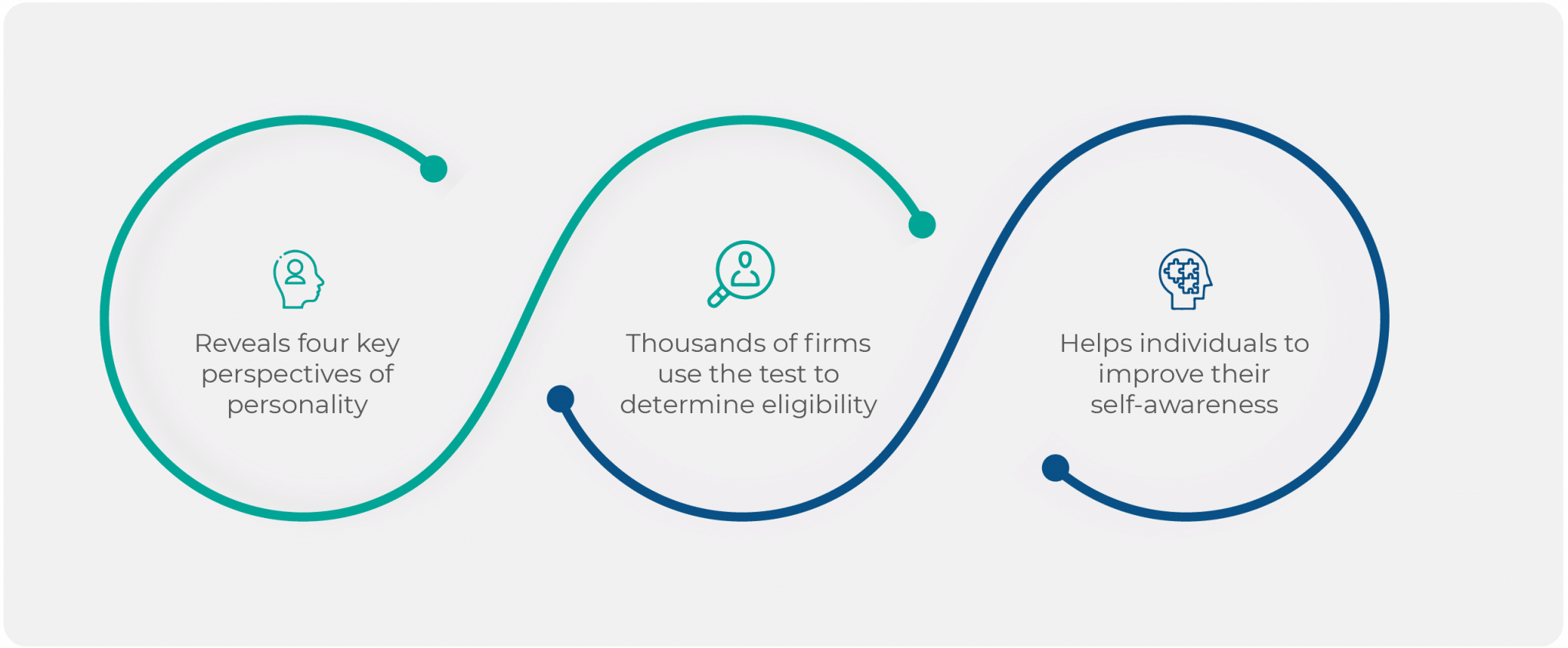
Employers Who Use the Birkman Personality Test
Thousands of mid-size and well-established firms, including Shell, JP-Morgan, and Coca-Cola, now use the Birkman personality test to determine candidates’ eligibility for a particular role.
Some of the issues that the companies can address through the Birkman Method include:
- Assisting in mergers and acquisitions
- Improving cognitive diversity
- Understanding the relationship between people and performance
- Reducing employee turnover
- Leadership/team conflict
By discovering how to support the employees’ productivity, companies can retain high-performing individuals and address concerns regarding a lack of engagement and miscommunication.
Benefits Individuals
Personality assessment is also beneficial for individuals as it helps them to improve their self-awareness which is a crucial skill in the workplace. Being aware of your motivations and behaviors helps you recognize your strength and weakness. Being aware of these traits can help you thrive in your organization.
Technical Facts
The Nine Personality Components of the Birkman Method
The Birkman Method consists of nine component scales, ten occupational interest scales, and six prospective meta-scales. The nine component scales are delineated further into three categories: Usual Behavior, Needs, and Stress Behavior. Together they provide a multidimensional examination of an individual’s personality.
These are the nine components of the Birkman Method:
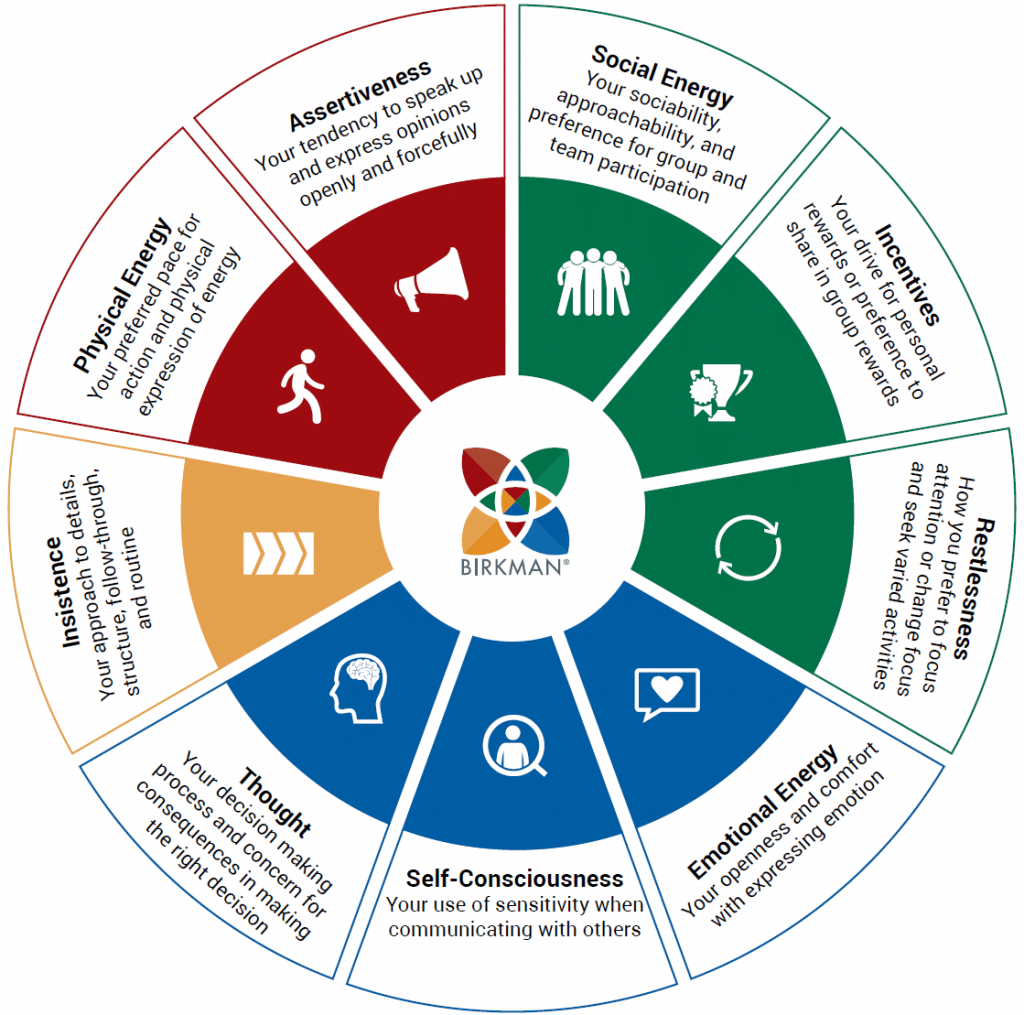
- Social Energy: This measures your level of sociability and preference for interacting with others, including your approachability and willingness to participate in group activities.
- Physical Energy: This measures your preferred pace for action and expression of energy, including your level of physical activity and energy.
- Emotional Energy: This measures your comfort with expressing emotions and feelings, including your openness and emotional range.
- Self-Consciousness: This measures your level of sensitivity and consideration when communicating with others.
- Assertiveness: This measures your level of confidence and willingness to express your opinions openly and forcefully.
- Insistence: This measures your approach to structure and follow-through, including your attention to detail and routine.
- Incentives: This measures your drive for personal achievement or preference for team-oriented rewards.
- Restlessness: This measures your approach to focusing your attention and seeking out new activities and experiences.
- Thought: This measures your decision-making process and consideration of the consequences of your actions.
Birkman Interests
The ten Birkman interest scales enable employers to compare the level of fit between the employee’s personality profile and occupational interests with the position the employee is holding or is about to hold.
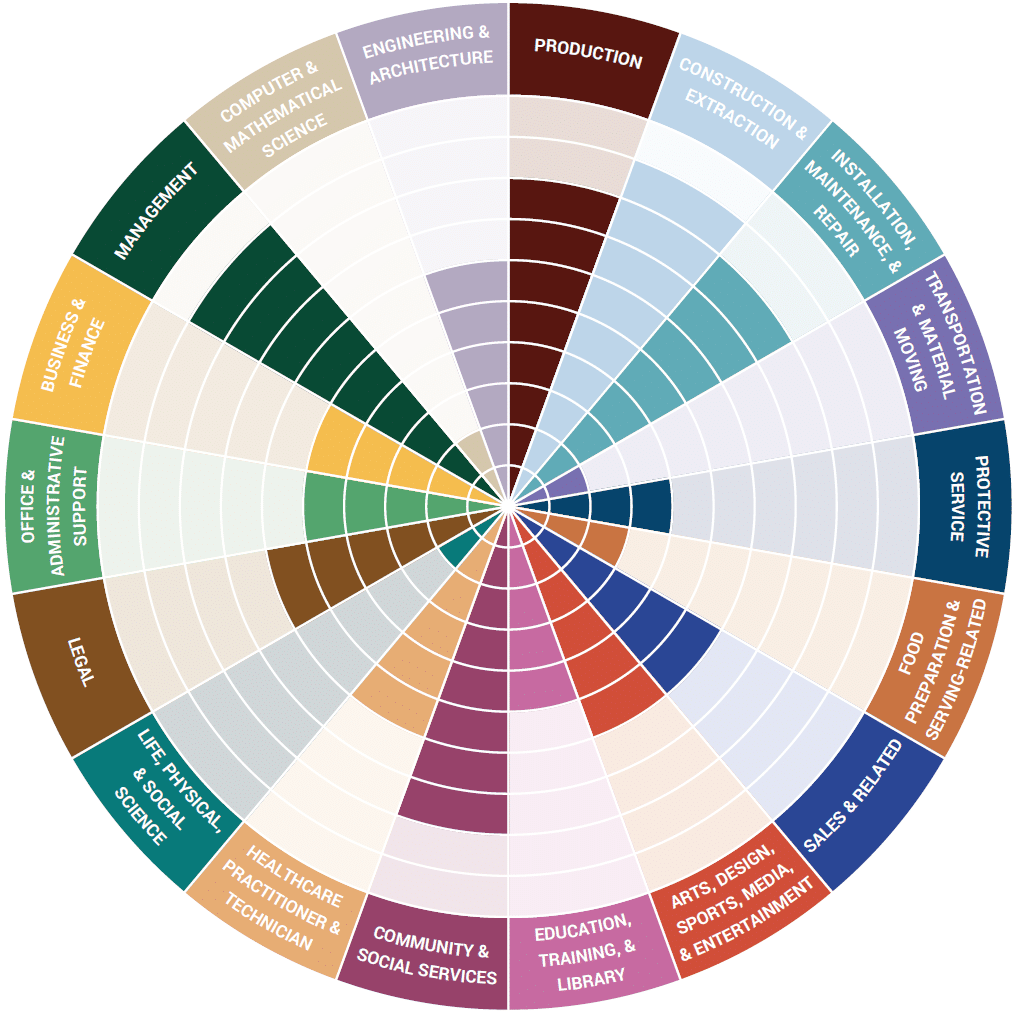
The following table lists the Birkman Interest Scales and what they measure.
| Scale | Description |
|---|---|
| Administrative | This scale measures an individual’s preference for career opportunities that involve service activities and administrative support. |
| Artistic | This scale measures an individual’s preference for career opportunities that involve architecture, photography, representational art endeavors, and design. |
| Literary | The literary scale measures an individual’s preference for career opportunities that involve reporting, editing, writing, and involvement with academic art and books. |
| Musical | This scale measures an individual’s preference for career opportunities that involve musical instruments, performing music, and general involvement with the musical arts. |
| Numerical | This scale measures an individual’s preference for career opportunities that involve accounting and bookkeeping, statistical and financial analysis, auditing, and mathematics. |
| Outdoor | This scale measures an individual’s preference for career opportunities that involve building and agricultural activities, adventure-oriented activities (outdoor activities), and working with animals. |
| Persuasive | This scale measures an individual’s preference for career opportunities that involve selling, persuading, communicating, and influencing activities such as management. |
| Scientific | This scale measures an individual’s preference for career opportunities that involve allied and medical applications, applied sciences, and research. |
| Social Service | This scale measures an individual’s preference for career opportunities that involve supporting, guiding, counseling, ministering, and educating others. |
| Technical | This scale measures an individual’s preference for career opportunities that involve semi-skilled and skilled mechanical crafts, troubleshooting and repair responsibility, engineering, and hands-on electronic work. |
Mindset
The Birkman Mindset Report consists of six meta-scales that are collectively called the perspectives. These six scales provide insight into the respondent’s belief systems concerning others and themselves. It is based on the data collected by the Birkman Method. It allows employers to better understand specific mindset elements.
The following table summarizes the Mindset scales and their definition.
| Perspective | Definition |
|---|---|
| Self-Affirming | The measure of favorable characteristics and the tendency to behave in a socially desirable way. |
| Others-Affirming | The measure of others’ favorable characteristics and their tendency to behave in a socially desirable way. |
| Image management | The measure of how much energy one devotes to managing and maintaining a favorable public image which is driven by affirmations and the affirmations of others |
| Distinctiveness | How unique the candidate sees themself in comparison to other individuals. |
| Alignment | How unique the candidate’s self-perception is from the standards of other individuals’’ self-perception. |
| Social Acuity | How closely the candidate’s interpretation of other people’s behavior matches the average impression of other people. |
Validity Of Results
The Birkman Method was established 70 years ago. Over the years, its utilization has grown significantly providing strong evidence that people perceive it to be valuable and accurate.
The Birkman test uses various personality measurements that establish divergent and convergent construct validity. The assessment model takes a deep dive into a person’s weaknesses and strengths by assessing the Five Factor Model constructs, the motivational factors, and the environmental contexts. This information can be used to discover the most accurate behavioral style which can be utilized in a variety of scenarios.
The information reveals the likely behavior of a person under a stressful situation so steps can be taken to prevent unwanted outcomes.
Language and Geography
The Birkman method assessment is available in over 21 languages. The fact that it’s an online test allows it to be accessible worldwide.
Results Scale and Interpretations
Birkman Results Analysis
The results of Birkman are relatively complex. Over 40 different reporting styles for the assessment are available. The results can represent one-to-one comparisons, individual respondents, and a group of respondents. There are various methods of breaking down and analyzing the results of all four categories (behaviors, stress management, motivations, and organizational orientation).
Although the Birkman method comprises many different techniques, its overall behavioral report description is placed into different categories which are then compiled together and represented through a chart.
After a proper analysis of the chart, the employer will decide whether you are a good fit for the role. As every profession has different requirements, it is crucial to have proper knowledge about the role you are applying for.
Birkman Chart/Map Explained
The Birkman method is a visual representation of your behavior that includes:
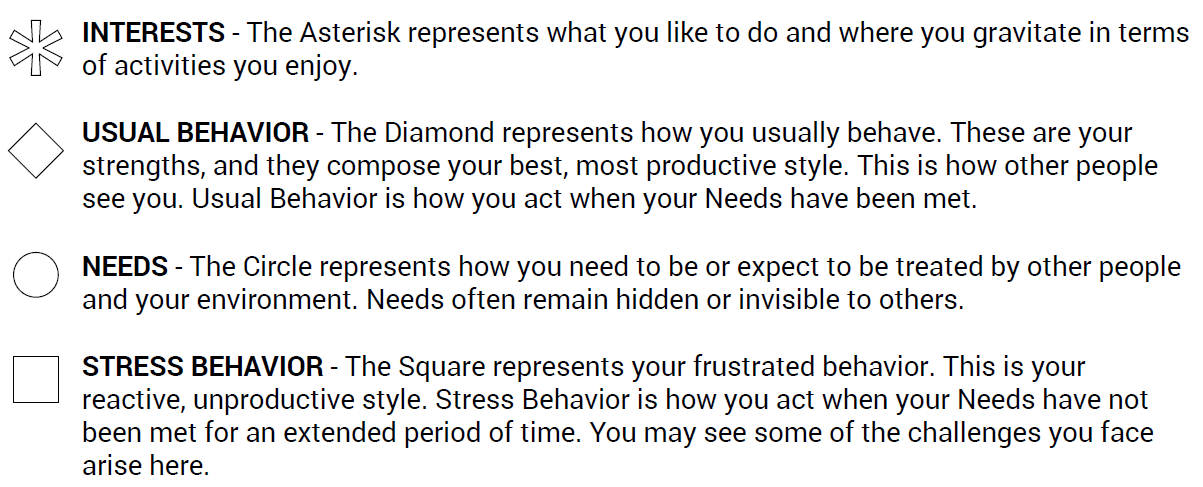
- Interests (Represented by an asterisk (*)): What you want to do, activities that you are interested in.
- Usual Behavior (Represented by a diamond (◆)): How you achieve your goals.
- Needs (Represented by a circle (●)): Ideal environment, how you prefer to be treated.
- Stress Behavior ( Represented by a square (■)): Your reaction when needs are not met.
These factors are measured by placing the symbols on a four-color grid. The color quadrants represent the specific personality type. The placement of each sign denotes the degree to which you display those behaviors.
Each color quadrant possesses unique skills and strengths that are integral to every successful team and organization.
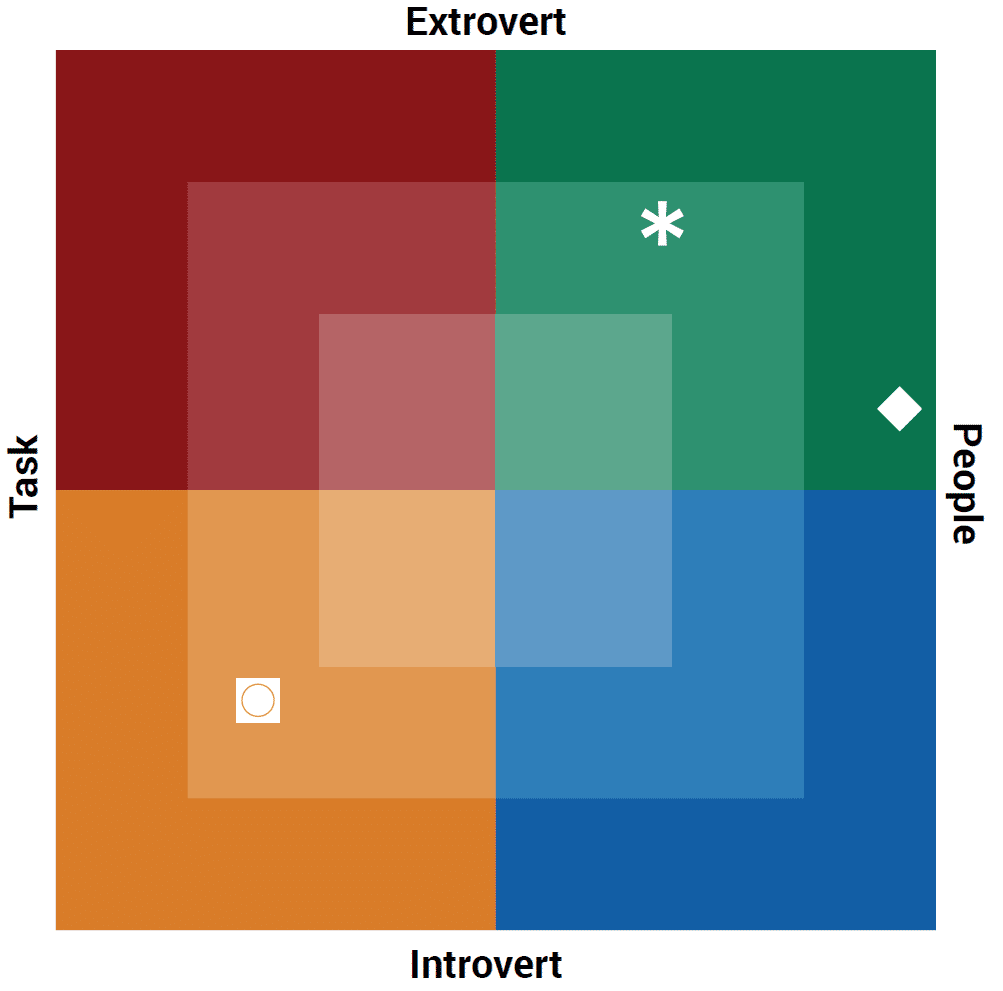
Red: Reds, also called DOERS, tend to be action-oriented. They are keen on directing and building things. They are decisive and energetic. They require people on their team to be direct and logical. They can display dismissive or aggressive behavior when their needs are not met.
Blue: Blues are the THINKER types. They are just the opposite of reds as they are more cerebral. They like to innovate and design and tend to be thoughtful and insightful. They require a lot of patience and support from their colleagues and may find it hard to continue when stressed.
Green: Greens are COMMUNICATORS. They tend to be highly focused and persuasive. They are often assertive and competitive. They require visibility, praise, and variety. They can be argumentative and domineering when stressed.
Yellow: Yellows are ANALYZERS. They are just the opposite of green. They are thoughtful and analytical. They are exceptionally detail-oriented. They require order and concentration and crave consistency. They are often stressed by change but will rarely confront others.
The right and left sides of the map represent your preference for dealing with people’s tasks. The top and bottom of the map represent whether you are more extroverted or introverted. If your behavior symbols lie on the right side of the map, you are more people-oriented in your approach. If it lies at the bottom, you are more introverted.
The placement of the symbols turns your behavior into a personality map that is simple to read, easy to remember and helps you better understand yourself and relate to others. It assists you in achieving your personal and professional goals.
Birkman Reports
Although the test questions are pretty straightforward and do not require much time to complete, breaking down and analyzing them could be rather complex. Once the test is over, the results are declared immediately and made available to the employer.
However, most organizations require an expert for the explanations of those results. Generally, the specialist takes around 1 to 1.5 hours to analyze and explain the test results.
The results report could be presented in any one of 40 styles. However, most companies prefer to analyze their employees through one of the following three report types:
- Birkman Basic Report
- Birkman Signature Report
- Birkman Advance Report
Birkman Basic Report
The Birkman Basic report maps out personality data, including strength, stress behavior, social expectations, and occupational interests. It’s an efficient and easily accessible tool that can be implemented in organizational training and many other employee-centric processes.
Since Birkman Basic is a scalable report, it is best suited for a company that wants to utilize personality assessment to maintain a consistent language for every employee.
Reasons to Choose Basic Report
- User-friendly and concise reporting format
- Provides perception insights and fast, actionable behavior
- Nurtures others’ awareness and self-awareness
- Drives tactical steps
- Scalable as business complexity and requirements increase
- Impacts performance positively
The only drawback of this report is that you are not provided with Birkman Components, known as the company’s secret sauce. This means the Basic Report will provide an overview of the personalities but it won’t get into the depth. As a result, you won’t be able to tackle goals such as leadership development, conflict resolution, hiring for high-value positions, etc. Overall, the Basic Report is perfect for team building and training activities, which do not require in-depth insights.
Birkman Signature Report
The Birkman Signature is an advanced report that delivers data-rich insights to drive organizational development and help individuals grow professionally. Its high-level personality data assists in increasing emotional intelligence, strengthening performance, and amplifying growth.
It also includes access to the Birkman component. The insight provided by these scales allows individuals to discover their unique behaviors, preferences, and beliefs regarding personal, organizational, and interpersonal situations.
Signature dives deep into the hidden tendencies for more significant insights.
Reasons to Choose Signature Report
- It can be utilized to teach individuals at every stage of the employee lifecycle.
- It covers insights that include blind spots and strengths.
- It measures behavior, interest, and motivation
- Its data is based on nine different components of behavior
- It can be utilized in every area of your organization to improve performance
Most organizations prefer to use both reports, Basic and Signature. While Basic is used for the selection of talent and team-building exercises, Signature is used for solving in-depth management issues. You would require the help of a Birkman expert to better understand the Signature report due to the complexity and depth of data presented.
Birkman Advanced Report
The Advanced Birkman report includes all the aspects of the primary and Signature report, along with a few more advanced components. It is an evolved version of the Signature report.
Components and, in particular, the interaction of various component scoring patterns, are explored in detail in the Advance report. Core emotional and rational reasons are found and thoroughly examined from a social psychology perspective. The Birkman advance report also looks at the Birkman Map’s identification of the components and the “natural” pairing of the components. These can be used to bring insight into various workplace issues and help your team move forward.
iPREP: Concise. Focused. What you need.
Sign up
Immediate access
Practice
Online self-paced
Pass
Ace that Test!
Birkman Assessment FAQs
Birkman’s assessment is a psychological assessment used by businesses to analyze an individual’s personality and behavior.
The assessment is based on a method inspired by Dr. Birkman’s experience in the US Air Force, where he observed how individuals’ inner motivation and perceptions impact their performance in the workplace.
The assessment is based on four personality perspectives:
Motivation
Self-Perception
Social-Perception
Stress-Behaviour
No. There are no right or wrong answers when we are talking about personality. The test aims to measure to what extent your character matches the job position’s requirements. Your performance depends on your awareness of the format of the assessment.
The product’s cost varies according to the type of test you opt for. The basic assessment report will cost around $129 and provides information regarding how your personality impacts your relationship, performance, and communication.
The test does not have a time limit but most people require around 45 minutes to complete the assessment.
Once you have completed the questionnaire, you will immediately get an automated summary of your performance. You can also pay for an expanded version of the report.
The Birkman assessment consists of 316 questions, 258 in True/False format and 58 in MCQ format.
The assessment is conducted online and can be taken at the preferred location of the employer.
No, the test is not timed. You may take as much time as required to complete it. However, in most cases, individuals take around 45 minutes to take the test.
Birkman Assessment Test Tips
Research the Company and Role
Although you cannot fail the assessment, messing it up might eliminate your chances of getting hired. Therefore, you must gather accurate information about the company and role you are applying for. There are certain personality traits that employers look for in candidates. It’s important to have a proper understanding of the role beforehand and analyze whether you are a good fit.
Answer Professionally
You may have heard the statement, “Honesty is the best policy.” Now is the time to implement it. Lying may land you a job, but it will be detrimental in the long term. However, many people have a different work persona as compared to their private life. Therefore, it’s best to put a professional foot forward while taking the test.
Take Your Time
The fact that the Birkman Assessment is not timed means you can use as much time as you like to answer the questions. Read every question and review all the answers after completing the test. Take full advantage of the lack of a time limit.
Practice
Your chances of performing well on the assessment will increase if you are familiar with the type of questions asked. Try out free personality tests available online as they will help you understand the structure and formatting of the Birkman Assessment. The practice tests will also help you figure out how to answer questions according to the role you are applying for.
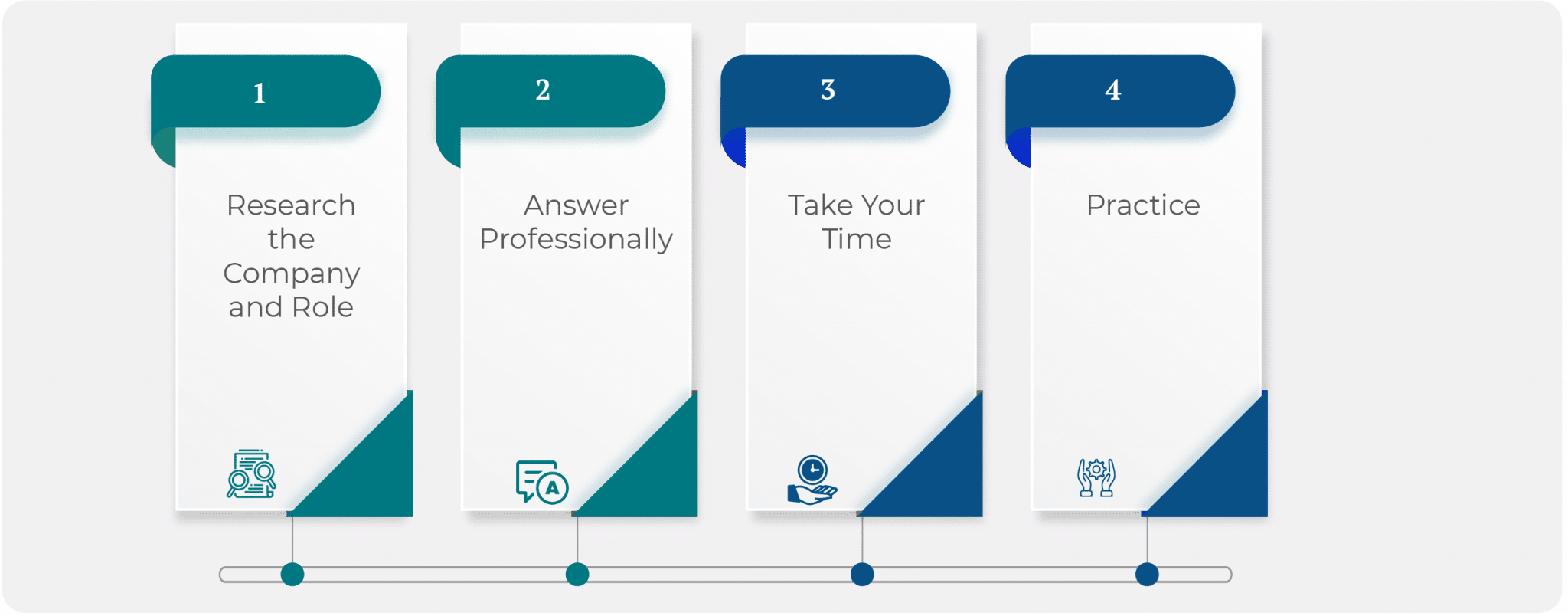
Administration
- Test Location: Because the test is online, it can be taken from any desired location.
- Test Schedule: The test is part of the hiring process
- Test Format: Section 1-True and false, Section 2- MCQ questions
- Test Materials: The test is taken on a computer so no additional materials are needed
- Cost: It depends on the type of report you choose but most tests are covered by the recruiter
- Retake Policy: As per the recruitment policy of your employer.
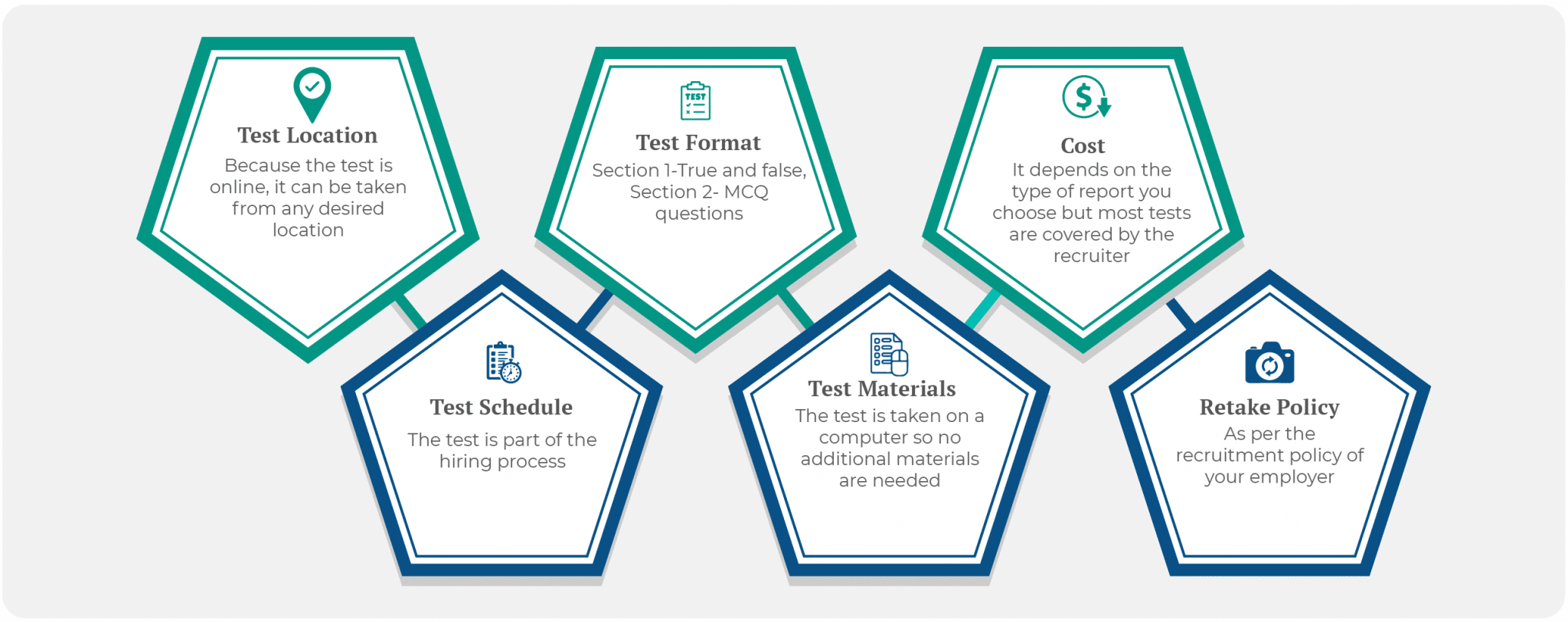
Test Provider
Birkman International is one of the most popular behavioral and occupational assessment companies. It was founded by organizational psychologist Dr. Roger W. Birkman in 1951. Birkman’s method of personality assessment is utilized by firms throughout the globe. It provides employers with a better understanding of the interpersonal dynamics of potential and existing employees. The evaluation is available in over 21 languages and is widely used in fields of leadership development, human resources management, organizational design, and career coaching today.
Disclaimer – All the information and prep materials provided on iPrep are genuine and were created for tutoring purposes. iPrep is not affiliated with Birkman International (BI), the owner of The Birkman Method, or any trademark or organization mentioned above.
Free Birkman practice test: Get to know what the Birkman Assessment test will be like by practicing with these sample questions:
Personality Statement 1 of 4
I often worry about my past mistakes –
- True
- False
This statement examines how guilt-free you are. It tries to assess whether you are quick to justify yourself after making a mistake or whether you are prone to worry about past mistakes.
If you answered “True” and you would answer similarly in other cases, it means that you are mistake-averse and tend to feel guilty about your mistakes. It also means that you will do your best to avoid them.
This is an important quality for people who deal with science and very expensive materials, and any mistake of theirs might be costly for the employer. On the other hand, it is not a highly needed quality for online marketers who practice trial and error quite a lot.
Personality Statement 2 of 4
I prefer spending time with open and outgoing people –
- True
- False
This statement assesses how likely you are to enjoy being in a work environment with high social interaction.
If you agreed with the statement, you may prefer working closely with people and wish to avoid working on your own. If you are neutral about the statement, then maybe you can appreciate jobs with different measures of social interaction.
Personality Statement 3 of 4
Most people have hidden motives when they offer help –
- True
- False
This statement tries to assess from a social perspective how cynical you are, whether you are prone to doubt others’ intentions and assume they have bad ulterior motives. Generally, it may reflect various aspects of trust or mistrust.
People who tend to agree with similar statements are prone to negativity and are quarrelsome. People who tend to disagree may not examine others’ true intentions carefully enough.
Personality Statement 4 of 4
| Which job do you prefer? Rank the job titles in order from most desired to least desired. |
|---|
| Laboratory Technician |
| Firefighter |
| Actor |
| Financial Consultant |
This statement is meant to evaluate your occupational interests and compare them to the requirements of your desired job. If there is alignment between the two, it suggests that you may be a good fit for the position. For instance, a laboratory technician position indicates interest in scientific work, a firefighter position indicates interest in outdoor work, an actor position indicates interest in artistic work, and a financial consultant position indicates interest in financial work.
Well done!
You have completed the Sample Questions section.
The complete iPREP course includes full test simulations with detailed explanations and study guides.
